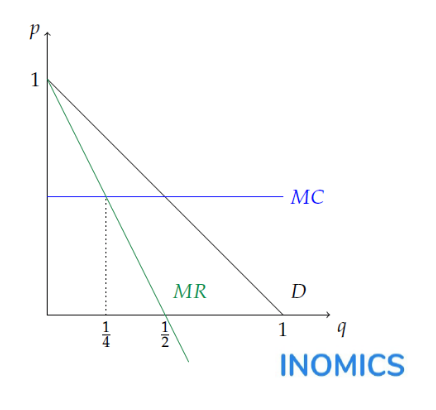First, set up the Lagrangian. We do this by maximizing the utility function subject to the constraint, like so;
maximize (with respect to q1, q2, and λ) the utility function U(q1,q2) = 3q1(½)*q2(½) subject to our budget constraint, which is 40 ≥ 10q1 + 3q2. This yields:
max U(q1,q2) = 3q1(½)*q2(½) - λ(10q1 + 3q2 - 40).
Next, take the partial derivatives with respect to each of the three variables, and set each of them equal to zero. This gives us:
\begin{equation*} \frac{\partial{L}}{\partial{q}_1} = \frac{3}{2}*\mathit{q}_1^\frac{-1}{2}*\mathit{q}_2^\frac{1}{2} - 10*\lambda = 0 \end{equation*} \begin{equation*} \frac{\partial{L}}{\partial{q}_2} = \frac{3}{2}*\mathit{q}_1^\frac{1}{2}*\mathit{q}_2^\frac{-1}{2} - 3*\lambda = 0 \end{equation*} \begin{equation*} \frac{\partial{L}}{\partial{\lambda}} = 10*\mathit{q}_1 + 3*\mathit{q}_2 - 4 = 0 \end{equation*}
Now solve this system of equations for q1, q2, and λ. Solve the first two partial derivatives for λ to get λ = (3/20)*q1(-½)*q2(½) and also λ = (1/2)*q1(½)*q2(-½). We can set these equal to each other to get a relation between q1 and q2, then solve; (3/20)*q1(-½)*q2(½) = (1/2)*q1(½)*q2(-½) yields (3/10)q2 = q1.
If we plug this relation into the last partial derivative, we will be able to calculate amounts for both goods. Then, use one of these amounts to solve the first or second partial derivative for the value of λ. Doing this gives q1 = 2, q2 = (20/3) or 6.6667, and λ = 0.274.
Finally, using the utility function, we can calculate the total utility from this product mix as 3*(2(½))*((20/3)(½)) = 10.9544.
This solution, buying two steaks and 6.6667 potatoes, is optimal. Why not see what happens if we choose a different product mix? For example, if we choose 7 potatoes and 2 steaks, the resulting utility is higher than before (roughly 11.22). But 7 potatoes and 2 steaks costs 41 dollars, which this customer cannot afford; we have violated the budget constraint! This shows that with more money, we can afford a higher level of utility. In fact, we have just confirmed the value of λ we calculated is correct. By increasing the budget constraint by $1, we have increased our utility by about 0.27. This was indeed the value for λ we calculated above.
Note that as the two goods are complements, if we choose zero of either good, utility will be zero. Thus it's always optimal to have some sort of mix of the two.
Let’s pick other product mixes that are within the budget constraint, to prove that we have found the best mix possible. If we choose 5 potatoes, we can afford 2.5 steaks; this product mix only produces a utility of 10.6, which is less than our optimal solution. Similarly, choosing 8 potatoes leaves us with 1.6 steaks, for a utility of 10.73.
So, it appears that the product mix we calculated with the Lagrange method is optimal after all!
> Go back to term definition



